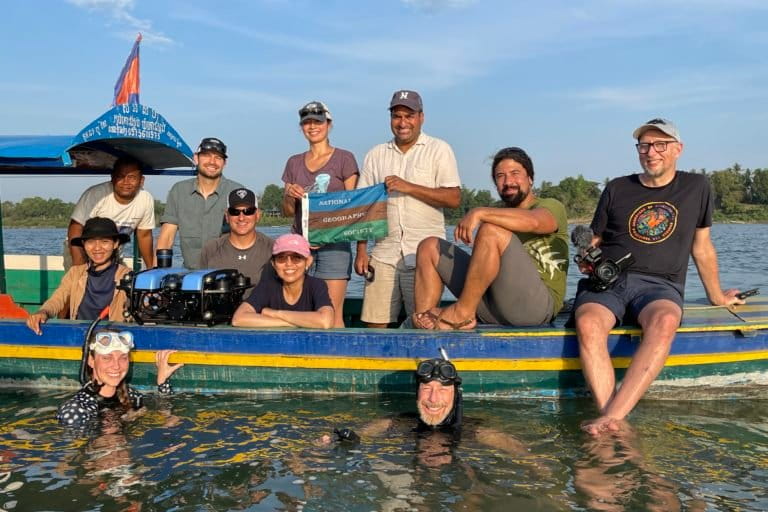
- An underwater expedition into the deepest pools in the Mekong River has confirmed the presence of giant freshwater fish, fish migration routes, and high volumes of discarded fishing gear and plastic waste.
- The international team of underwater explorers, local fish biologists and fishermen used deep-sea camera technology to document the ecological value of the unique area in northeastern Cambodia, which is characterized by 80-meter-deep (260-foot) pools, flooded forests and braided river channels.
- But just as researchers reveal the value of its biodiversity, food security and fisheries livelihoods, the area faces a new threat: earlier this year, feasibility surveys began for a hydropower dam planned for directly upstream of the deep-pool habitats.
- According to the expedition team, construction of the Stung Treng dam would have “devastating ecological effects and could seriously threaten local food security in an area of the world already impacted by changing climate.”
An underwater expedition has confirmed the presence of some of the world’s largest and most threatened freshwater fish in a remote and barely studied stretch of the Mekong River in northeastern Cambodia. The findings included a 180-kilogram (400-pound) giant freshwater stingray that was captured and released in collaboration with local fishermen, but also revealed several “worrisome” threats facing the unique aquatic habitats.
During the weeklong investigation in Cambodia’s Stung Treng province earlier this month, the international team of underwater explorers and local fish biologists used remotely operated submersibles, baited video cameras, and dropcams suspended on long cables to capture the first ever videos of life in the Mekong’s deepest pools, which plunge down to 80 meters (260 feet).
“No one’s observed what’s going on underwater in this area before — it’s very deep water, very hard to study, and very inaccessible,” Zeb Hogan, a fish biologist and leader of the Wonders of the Mekong project, told Mongabay. The expedition was partly an effort to corroborate local fishers’ tales of catching giant fish in the pools, he added.
In addition to the endangered giant stingrays (Urogymnus polylepis), the area is thought to be home to Mekong giant catfish (Pangasianodon gigas) and giant barbs (Catlocarpio siamensis), both of which are listed as critically endangered on the IUCN Red List due to a range of threats, including overfishing, drought and habitat destruction. The deep pools are also a last refuge for the Mekong’s only remaining population of critically endangered freshwater Irrawaddy dolphins (Orcaella brevirostris).
Besides the deep-water areas, the Mekong runs through flowing channels, flooded forests, shallow mudflats, sandbars, and rocky outcrops, creating a diversity of aquatic habitats that provide crucial spawning grounds for many of the river’s 1,000 or so fish species. In turn, the fish underpin the food security and livelihoods of millions of Cambodians who as a nation derive roughly three-quarters of their dietary protein from the river.
“Studies have calculated that 200 billion baby fish are produced out of this area,” Hogan said. “When the floods come, a lot of these fish spawn as the water levels rise and the young are dispersed downstream throughout Cambodia and even down into Vietnam. So this is a spawning area that’s churning out fisheries production for the whole [region].”

Migrations and behemoths
Although the underwater view was obscured by sediment in the water that limited visibility to roughly 1 m (3 ft) and made it difficult to tell up from down, the expedition team gained several insights into how fish use the deep pool areas.
Cameras showed schools of migratory catfish congregating at a depth of 75 m (250 ft), while other species appeared to be actively migrating straight through the area, according to Hogan. He recognized the latter as a species of catfish that used to migrate over the Khone Falls in southern Laos, once forming the basis of a community fishery. However, when the Don Sahong hydropower dam was completed in 2020, the migration route was obstructed and the fishery collapsed, he said.
“It seems these fish are still making that migration,” Hogan said. “But we don’t know where they’re going now … Are they spawning just below the Khone Falls? Or are they going up there and just getting blocked?”
Underwater footage also confirmed that some species, such as the mouse-faced fish (Helicophagus waandersii) whose diet of snails and shrimp was previously only known from the stomach contents of dead specimens in markets, forage in the extreme depths of the river. “It was really cool to actually observe these fish doing what we always suspected they were doing, but had never confirmed,” Hogan said.

The team also filmed high concentrations of small fish like silver barbs in a community fish reserve set up to protect fish spawning grounds adjacent to the deep pools. And at night, members of the crew heard tail slaps of giant sheatfish (Wallago attu) from the reserve. These findings back up prior research showing the effectiveness of freshwater community fish reserves in the region.
But arguably the most exciting discovery came toward the end of the expedition, when a network of local fishermen who had agreed to report catches of giant and endangered fish informed the expedition team of a gargantuan catch. They had accidentally landed a 4-m (13-ft) giant freshwater stingray weighing in at 180 kg in one of the deep pools. After taking measurements, the fishermen and project team returned the animal to the river. Notwithstanding its colossal size, the team’s interviews with local fishers indicate there might be even larger rays living in the area.

Troubling signs
But just as researchers are beginning to reveal its vital ecological and economic importance, this stretch of the Mekong faces a major threat. The researchers witnessed “worrisome” signs of preliminary surveys for a planned 1,400-megawatt hydropower dam slated for an area directly upstream of the core deep-pool zone.
Cambodia’s 2020-2030 energy master plan doesn’t include any hydropower dams on the mainstream Mekong. However, local media reports indicate that the dam has government approval “in principle.” The dam would be the second major hydropower scheme in Stung Treng province, with the Lower Sesan 2 dam already operating on a tributary of the Mekong.
According to the expedition team, construction of the dam in such a topographically and biologically rich stretch of the river would have “devastating ecological effects and could seriously threaten local food security in an area of the world already impacted by changing climate.”
“Dams are a unique threat to fish and are what cause extinctions,” Hogan said. “Fishing pressure has always been incredibly high in the Mekong, and you can see the evidence of intense fishing pressure [in the scarcity] of big fish species … But it is very rare that overfishing leads to extinctions. Whereas if you put one of these dams in, you might lose dozens of species from one dam.”

The underwater equipment also frequently encountered discarded fishing lines and nets, and plastic waste was evident in almost every video clip — even in the deepest and remotest parts of the river.
Hogan said the expedition is just the beginning of efforts to document the importance of this part of the Mekong River. His team is moving forward with plans to establish a field research station from which to continue collaborating with fishing communities and carrying out long-term monitoring work. Their next step will be to set up a series of acoustic sensors along the river stretch to help them track fish migrations.
As Hogan describes it, this imperiled section of the river is symbolic of the entire Mekong River: “Critically important, understudied, and under threat.”
Banner image: A four-meter (13-foot) freshwater stingray was accidentally caught by fishermen in a deep pool in Stung Treng province in early May 2022. Interviews with local fishers indicate there might be even larger rays living in the area. Photo courtesy of Wonders of the Mekong
Citation:
Koning, A. A., Perales, K. M., Fluet-Chouinard, E., & McIntyre, P. B. (2020). A network of grassroots reserves protects tropical river fish diversity. Nature, 588(7839), 631-635. doi:10.1038/s41586-020-2944-y
Carolyn Cowan is a staff writer for Mongabay. Follow her on Twitter @CarolynCowan11
FEEDBACK: Use this form to send a message to the author of this post. If you want to post a public comment, you can do that at the bottom of the page.
In the Mekong’s murky depths, giants abound, new expedition finds
Source: Trends News


0 Comments